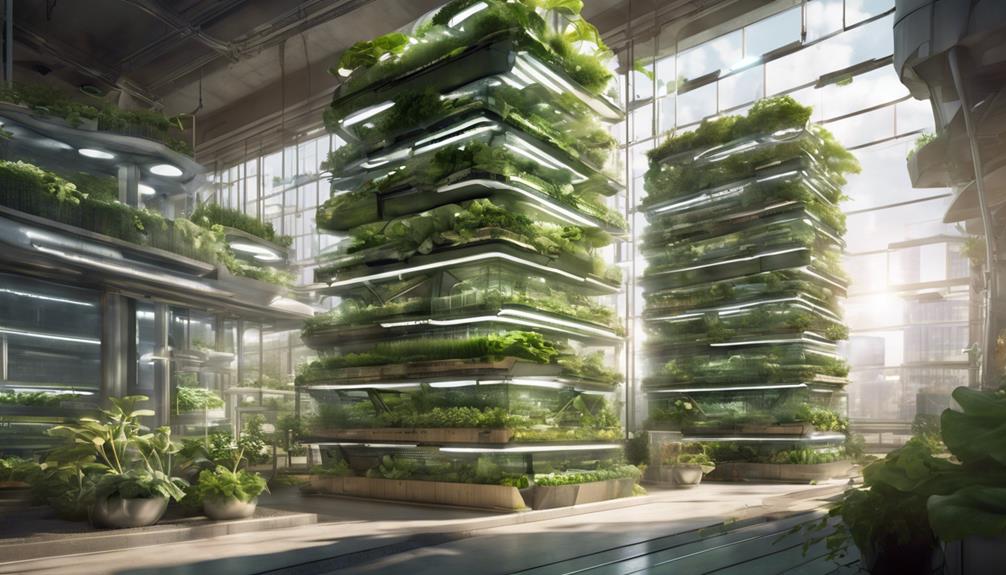Very Important Role Of Vertical Farming In Food Security

Role Of Vertical Farming In Food Security by optimizing crop yields in urban areas while conserving resources. You benefit from fresh produce that’s grown closer to where you live, cutting transportation emissions and ensuring access to nutritious food. These farms use innovative techniques like hydroponics and aeroponics, which rely on minimal water and eliminate soil degradation. Additionally, controlled environments protect against pests and diseases, creating a sustainable supply of food year-round. By integrating technology and efficient practices, vertical farms can adapt to climate challenges, enhancing resilience in food systems. Discover how these advancements shape the future of agriculture beyond this point.
Understanding Vertical Farming
In recent years, vertical farming has emerged as a revolutionary approach to agriculture, transforming how we think about food production. You may be surprised to learn that this innovative method allows crops to grow in stacked layers, utilizing vertical space often found in urban environments. With the rise of urban agriculture, vertical farming addresses the challenges of limited land availability and population density.
One key aspect of vertical farming is the use of soil alternatives. Traditional farming relies heavily on soil quality, which can vary considerably from one location to another. In contrast, vertical farms often utilize hydroponics, aeroponics, or aquaponics to support plant growth. These systems allow you to cultivate plants without soil, using nutrient-rich water solutions or mist instead. This not only conserves water but also minimizes the risk of soil-borne diseases and pests, leading to healthier crops.
By integrating technology into the farming process, you can optimize growth conditions such as light, temperature, and humidity. This precise control helps maximize yield while reducing resource consumption. Additionally, vertical farming can greatly reduce the carbon footprint associated with transporting food long distances, as it brings fresh produce closer to urban consumers.
As you explore the world of vertical farming, you’ll see how it represents a shift towards more sustainable, efficient food production methods. This innovative approach not only redefines agriculture but also plays a vital role in addressing food security in our rapidly urbanizing world.
Benefits of Vertical Farming
Vertical farming offers impressive space efficiency, allowing you to grow more food in less area. It also conserves resources like water and energy, making it a sustainable choice for modern agriculture. By embracing this innovative method, you can contribute to a more secure food future while maximizing your environmental impact.
Space Efficiency
Maximizing limited urban spaces for agriculture, vertical farming offers an innovative solution to food production challenges. You can efficiently use multi-layered systems to grow a variety of crops in confined spaces, markedly increasing yield per square foot compared to traditional farming. This spatial design not only optimizes available land but also allows you to implement effective crop rotation practices. By rotating crops in a vertical setup, you maintain soil health and enhance nutrient availability, which is often a challenge in conventional farming.
With vertical farms, you can take advantage of urban rooftops, abandoned warehouses, and other underutilized areas, bringing food production closer to the consumer. This proximity helps reduce transportation costs and emissions, while ensuring fresher produce. Plus, you can control the growing environment, meaning fewer pests and diseases, which can save space that would otherwise be used for pest management. Ultimately, vertical farming transforms the way you think about agriculture in urban settings, allowing you to produce more food sustainably and efficiently, regardless of limited land availability.
Resource Conservation
Urban agriculture not only redefines space efficiency but also plays an essential role in resource conservation. By adopting vertical farming practices, you can greatly enhance water recycling. This method uses considerably less water compared to traditional farming, allowing for efficient irrigation systems that minimize waste. You’ll also benefit from improved energy efficiency, as controlled environments reduce energy consumption for lighting and climate control.
Soil conservation is another major advantage. Vertical farms often rely on hydroponics or aeroponics, eliminating the need for soil and reducing land degradation. With effective nutrient management, you’ll guarantee that crops receive essential vitamins and minerals while minimizing chemical runoff.
Moreover, vertical farming contributes to climate resilience, adapting to changing weather patterns and urban heat effects. You’ll also see waste reduction, as organic waste can be composted or used for biogas production, closing the loop in the food system. Biodiversity enhancement is vital; rotating crops and employing integrated pest management can naturally control pests and diseases. Finally, community involvement thrives in vertical farms, fostering local engagement and support. By embracing these practices, you’ll contribute to a sustainable future.
Vertical Farming Techniques
When you think about vertical farming techniques, you can’t overlook hydroponics and aquaponics, which offer innovative ways to grow crops without soil. Aeroponic systems take it a step further by using mist and air to nourish plants, maximizing efficiency. Controlled environment agriculture guarantees that every factor, from light to humidity, is optimized for the best yield.
Hydroponics and Aquaponics
In recent years, hydroponics and aquaponics have emerged as revolutionary techniques in vertical farming, offering sustainable solutions for food production. These methods allow you to optimize nutrient delivery directly to plants, ensuring they receive exactly what they need for growth. You can enjoy system scalability, meaning you can easily expand your setup as demand increases.
Crop selection becomes more diverse, as hydroponics and aquaponics can support various plants, from leafy greens to herbs and even fish in aquaponics systems. Effective pest management is essential, and these systems often reduce pest pressure through controlled environments.
When it comes to energy consumption, you’ll find that these techniques can be more efficient than traditional farming, utilizing less land and resources. Water recycling is another significant advantage, as both systems minimize water waste, making them ideal in water-scarce regions.
Market accessibility improves as these farms can be set up closer to urban areas, reducing transportation costs. Finally, consumer education plays a key role in promoting these innovative techniques, helping people understand the benefits of locally sourced, sustainably grown food.
Aeroponic Systems Explained
One innovative technique gaining traction in vertical farming is aeroponics, which involves growing plants in a mist or air environment without soil. This method offers several aeroponic advantages, like enhanced plant growth and efficient nutrient delivery. By using a nutrient-rich mist, plants can absorb the essentials more rapidly, often resulting in higher crop yield compared to traditional methods.
However, aeroponics also comes with its challenges. Effective system design is vital to guarantee proper air circulation and moisture levels. If the mist isn’t distributed evenly, it can lead to uneven growth or even crop failure. Energy consumption is another factor to take into account, as maintaining ideal conditions may require significant power, impacting overall sustainability.
Scalability issues can arise when trying to implement aeroponic systems in larger operations, as they often require upfront investment and technological expertise. Despite these challenges, market adoption of aeroponic systems is increasing, driven by the demand for sustainable agriculture solutions. As you explore aeroponics, weighing the benefits against the challenges will help you determine if this innovative method aligns with your vertical farming goals.
Controlled Environment Agriculture
Controlled Environment Agriculture (CEA) revolutionizes the way we think about food production by creating optimized growing conditions for plants. By harnessing advanced technologies, you can achieve climate resilience and guarantee crops thrive regardless of external weather conditions. This method promotes urban integration, allowing you to grow fresh produce right where it’s needed most, enhancing market accessibility.
With CEA, you can engage your community through education initiatives, teaching sustainable practices and the benefits of locally sourced food. The nutritional enhancement of crops grown in controlled settings means healthier options for everyone. Plus, the scalability potential of these systems allows you to expand your operations as demand grows.
Pest management becomes more efficient in a controlled environment, reducing reliance on harmful chemicals. You can also implement crop rotation strategies to maintain soil health and prevent disease. As you adopt these technologies, you’re not just improving food security; you’re also fostering a sense of community and responsibility towards sustainable practices. Embrace CEA to transform your approach to food production, making it more resilient, efficient, and accessible for all.
Environmental Impact
Vertical farming greatly reduces the environmental impact of traditional agriculture. By utilizing advanced sustainability practices, it minimizes the carbon footprint associated with food production. You’ll find that vertical farms require remarkably less land and water, which leads to effective soil conservation and waste reduction. These methods not only help preserve natural resources but also enhance biodiversity by creating controlled environments that can foster a variety of plants.
Moreover, energy consumption in vertical farms can be optimized through the use of renewable energy sources and energy-efficient technologies. This shift not only lowers greenhouse gas emissions but also contributes to climate resilience, making these farms more adaptable to changing weather patterns. When you consider urban greening, vertical farms can transform cityscapes, providing fresh produce while improving air quality and reducing urban heat.
Vertical farming also aligns well with environmental regulations aimed at reducing the ecological impact of agriculture. By operating in controlled environments, these farms can greatly reduce pesticide and fertilizer use, further benefiting local ecosystems. The ecological benefits extend beyond the farm itself, as they contribute to healthier urban environments, fostering community engagement and awareness of sustainable practices.
Economic Advantages
When you consider vertical farming, you’ll find it offers significant cost efficiency in production compared to traditional farming methods. This innovative approach not only optimizes resources but also has the potential to create numerous jobs in urban areas. As you explore these economic advantages, you’ll see how vertical farming can reshape the future of food security.
Cost Efficiency in Production
One of the most compelling aspects of vertical farming is its potential for cost efficiency in production. By utilizing advanced technology and innovative growing methods, you can markedly lower operating costs compared to traditional farming. A thorough cost analysis reveals that vertical farms require less land and water, reducing overhead expenses.
Moreover, the production scalability of vertical farms allows you to expand operations without the substantial costs associated with land acquisition or soil management. As you optimize your vertical farming system, you’ll notice a decrease in labor costs, thanks to automation and precise climate control. This means you can produce more food with fewer resources, ultimately boosting your profit margins.
Additionally, vertical farming often allows for year-round production, minimizing the volatility of seasonal crops and ensuring a consistent supply. As you harness these economic advantages, you’ll find that the initial investment pays off quickly. By embracing vertical farming, you not only enhance your bottom line but also contribute to a more sustainable food system, addressing food security challenges effectively. The future of efficient, cost-effective food production lies in the heights of vertical farming.
Job Creation Potential
As vertical farming techniques become more prevalent, they hold significant promise for job creation within local economies. These innovative approaches to agriculture can lead to various job opportunities, fostering economic empowerment in the process. By establishing local partnerships, you can help cultivate workforce diversity and create entrepreneurial opportunities that benefit everyone.
Job training programs focused on agricultural education are essential for equipping individuals with the skills needed to thrive in this emerging field. As you participate in community engagement initiatives, you’ll find that skill development is a cornerstone of successful vertical farming ventures. These innovation hubs can serve as incubators for sustainable careers, allowing individuals to explore new technologies and practices in agriculture.
Moreover, vertical farming can attract a diverse workforce, giving people from different backgrounds a chance to contribute to food security. By investing in job training and agricultural education, you’re not just creating jobs; you’re building a resilient community that values sustainability. The potential for job creation in vertical farming is vast, and by harnessing it, you can play an essential role in shaping a more sustainable future for food production.
Resource Optimization Benefits
Vertical farming offers remarkable resource optimization benefits that can greatly enhance economic advantages. By utilizing advanced technologies and innovative growing methods, you can maximize your resource allocation. This means using less water, energy, and land compared to traditional farming methods. With vertical systems, you can create controlled environments that minimize waste and enhance efficiency, which leads to significant cost savings.
Yield optimization is another key benefit. In a vertical farm, you can grow crops year-round, unaffected by seasonal changes. This consistent production means you can meet market demands more reliably, reducing the risk of food shortages and price fluctuations. Additionally, by growing closer to urban centers, you cut transportation costs and minimize spoilage.
Investing in vertical farming not only supports sustainable practices but also boosts your bottom line. You’ll find that the initial investment can quickly pay off through reduced operational costs and increased productivity. As a result, you can contribute to food security while enjoying economic growth. Embracing these resource optimization benefits positions you at the forefront of a transformative agricultural movement, ensuring a resilient and sustainable future.
Urban Food Production
Urban food production has emerged as an essential solution to the challenges of feeding growing city populations. By integrating agriculture into urban spaces, you can directly access fresh, nutritious food while reducing the carbon footprint associated with long-distance transportation. This method not only meets immediate food needs but also fosters community engagement. When you participate in local farming initiatives, you strengthen ties with your neighbors and promote a sense of belonging.
Local partnerships play a significant role in the success of urban food production. Collaborating with schools, businesses, and non-profits helps create a robust network that supports sustainable practices. You can work together to establish community gardens, rooftop farms, and vertical farms, transforming underutilized spaces into thriving food sources. These partnerships not only enhance food security but also provide educational opportunities, teaching essential skills related to agriculture and nutrition.
Moreover, urban food production encourages the use of innovative techniques and technology. As you explore vertical farming, you’ll discover how it maximizes space and resources, allowing you to grow a variety of crops year-round. This approach not only boosts local food supplies but also supports economic growth by creating jobs in urban agriculture.
Crop Diversity in Vertical Farms
Integrating crop diversity in vertical farms enhances the benefits of urban food production by maximizing yield and resilience. When you diversify the crops you grow, you’re not just increasing the variety on your plate; you’re also fostering a more sustainable farming ecosystem. By employing effective crop selection strategies, you can choose plants that thrive in controlled environments, leading to higher productivity and better resource use.
Crop diversity isn’t just about aesthetics; it plays an essential role in biodiversity enhancement. Different crops can attract beneficial insects and promote healthier plant interactions, reducing the need for chemical inputs. This proactive approach helps create a more balanced ecosystem within your vertical farm, which can lead to improved pest management and disease resistance.
Moreover, by cultivating various crops, you also spread your risk. If one crop suffers from disease or market fluctuations, others can help maintain your farm’s overall productivity. This stability is especially important in urban settings, where food security is a growing concern.
As you decide which crops to grow, consider the nutritional value and market demand as well. This not only supports local food needs but also guarantees that you’re contributing to a robust urban food system. To sum up, embracing crop diversity in vertical farms can greatly enhance resilience, sustainability, and food security, paving the way for a healthier urban future.
Technology in Vertical Farming
Innovation lies at the heart of modern vertical farming, transforming how we approach food production. You’ll find that technology plays a essential role in this transformation, enhancing efficiency and sustainability. Sensor technology is fundamental, allowing you to monitor real-time conditions like moisture, temperature, and nutrient levels. This data feeds into automation systems, which streamline processes and reduce manual labor.
With data analytics, you can gain insights into plant growth patterns and enhance your nutrient management strategies. This means healthier crops and higher yields. Energy efficiency is significant, too, as vertical farms often use LED lighting, which consumes less energy while providing the ideal light spectrum for photosynthesis.
Climate control technologies enable you to create the perfect environment for your plants, regardless of the external weather conditions. By integrating robotics, you can automate tasks like planting, harvesting, and packaging, freeing up your time for more important decisions. IoT applications further enhance connectivity and data sharing, allowing for seamless operation across various systems.
Moreover, software solutions are critical in managing the entire farming process. They help you analyze data for growth enhancement, ensuring that you’re always on top of your crop’s needs. As you embrace these technologies, you’ll not only improve the sustainability of your operations but also contribute to food security in a rapidly changing world. By leveraging these advancements, you can cultivate a more efficient, productive, and responsible approach to agriculture.
Challenges Facing Vertical Farming
While technology greatly enhances vertical farming‘s efficiency and sustainability, several challenges still impede its widespread adoption. One major hurdle is scalability issues. You might find that many vertical farms struggle to expand operations due to high upfront costs and complex logistics. Coupled with market competition from traditional agriculture, this can make it tough for new entrants to succeed.
Investment barriers also play a significant role; securing funding for innovative farming methods can be challenging, especially when potential investors are wary of unproven technologies. Public perception can further complicate matters, as some consumers are skeptical about the nutritional value and safety of produce grown indoors.
Regulatory challenges can’t be overlooked either. Maneuvering local laws and obtaining necessary permits can be time-consuming, often stalling progress. Additionally, energy consumption is a pressing concern; many vertical farms rely on artificial lighting and climate control, which can lead to high operational costs.
Technological limitations are another significant challenge. While advancements are being made, pest management in a controlled environment remains tricky, and any failures can impact crop yield. Finally, supply chain logistics pose a threat to effectiveness. If you can’t efficiently transport your produce to market, the benefits of vertical farming diminish.
Case Studies and Success Stories
Across the globe, vertical farming is proving its potential through a variety of successful case studies. One standout initiative is the AeroFarms facility in Newark, New Jersey, which utilizes technology integration to grow fresh produce year-round. By leveraging innovative partnerships with local chefs and restaurants, they guarantee market accessibility and promote local sourcing. This approach not only supports urban agriculture but also enhances community engagement, as residents can participate in workshops and educational programs.
In Singapore, the Sky Greens project exemplifies climate resilience. By employing a unique rotating vertical farming system, they maximize sunlight exposure and minimize water usage. This initiative not only meets local demand for fresh vegetables but also contributes to the nation’s food security. The health benefits of consuming freshly harvested produce are evident, as it reduces the carbon footprint associated with transportation.
In the Netherlands, urban vertical farms like PlantLab are making strides in optimizing space and resources. Their focus on efficiency and sustainability through technology has led to successful initiatives that supply fresh greens to local supermarkets, further supporting market accessibility. Additionally, they engage with schools to educate the next generation about sustainable food practices.
These case studies illustrate how vertical farming can address food security challenges, promoting health, sustainability, and community involvement. As you can see, these success stories highlight the transformative potential of vertical farming, paving the way for a more resilient food system.
Future Trends in Vertical Farming
As success stories in vertical farming continue to emerge, it’s clear that the industry is on the brink of significant evolution. You’ll likely see future innovations that leverage cutting-edge technologies, enhancing efficiency and productivity. With ongoing technological advancements, including artificial intelligence and IoT, vertical farms can optimize growth conditions and yield while minimizing resource use.
Market expansion is another trend to monitor. As consumer acceptance of locally sourced and sustainably grown food increases, you’ll find more urban areas adopting vertical farming. This shift will encourage investment trends that focus on scalable solutions, fostering new business models to meet growing demand.
Sustainable practices will also become more critical. As you engage with these farms, you’ll notice a strong emphasis on reducing waste and conserving water, aligning with global sustainability goals. Educational initiatives will play a pivotal role in raising awareness about the benefits of vertical farming, empowering communities to support and participate in these efforts.
However, scalability challenges remain. You’ll need to evaluate how to scale operations without compromising quality or sustainability. Regulatory frameworks will evolve to address these challenges, providing clearer guidelines for vertical farming practices.
Community engagement will be essential as well. By involving local stakeholders, you can create a more resilient food system that benefits everyone. As these trends unfold, the future of vertical farming looks promising, paving the way for a more secure and sustainable food landscape.
Policy Implications for Food Security
Effective policy implications for food security hinge on integrating vertical farming into broader agricultural strategies. By developing robust policy frameworks, you can establish regulatory standards that encourage innovation while ensuring safety and sustainability. Funding strategies should prioritize public-private partnerships that can drive agricultural innovation and enhance market access for vertical farms.
Community engagement is essential; involving local stakeholders in decision-making fosters a sense of ownership and increases the likelihood of successful implementation. Education programs can raise consumer awareness about the benefits of vertical farming, highlighting its potential to address health implications and enhance food security.
To achieve sustainability goals, policies must promote technology adoption and research initiatives focused on climate resilience. This includes investing in urban planning that integrates vertical farming into city landscapes, ensuring that these farms are accessible to underserved communities and consider equity considerations.
International collaboration is vital for sharing best practices and knowledge, enabling countries to learn from each other’s experiences in vertical farming. In addition, food policies need to reflect the changing dynamics of urban agriculture, ensuring that vertical farms have a seat at the table in discussions about future food systems.
Role Of Vertical Farming In Food Security; Frequently Asked Questions
How Does Vertical Farming Compare to Traditional Farming in Terms of Yield?
When you compare vertical farming to traditional farming, you’ll find vertical systems often achieve higher yield optimization through controlled environments. They also enhance resource efficiency, using less water and land while maximizing production per square foot.
What Types of Crops Are Most Suitable for Vertical Farming Systems?
You’ll find that leafy greens, herbs, and small fruiting crops thrive in vertical systems. Crop selection is essential; choose varieties that adapt well to controlled environments and maximize space efficiency for best yield.
Are There Specific Regions Where Vertical Farming Is More Successful?
You’ll find vertical farming thriving in urban areas where technology integration meets consumer acceptance. Regions focusing on sustainability face regulatory challenges but benefit from positive market trends and reduced environmental impact, enhancing overall agricultural efficiency.
How Do Vertical Farms Manage Pests and Diseases Effectively?
You’ll find that vertical farms effectively manage pests and diseases through integrated pest management techniques and by using disease-resistant crops. This proactive approach minimizes chemical usage and promotes a healthier growing environment for your plants.
What Is the Average Cost of Starting a Vertical Farm?
Starting a vertical farm typically requires a significant initial investment, often ranging from $50,000 to several million. You’ll also need to take into account ongoing operational expenses, including utilities, labor, and maintenance, which can add up quickly.
Conclusion
In summary, vertical farming plays an essential role in enhancing food security by utilizing innovative techniques and maximizing space efficiency. You can see its potential in urban areas where land is scarce, providing fresh produce year-round while minimizing environmental impact. Though challenges exist, the economic advantages and success stories highlight its promise. By embracing future trends and supporting policies that promote vertical farming, you can contribute to a more sustainable and secure food system for everyone.








